How Author Timothy Tyson Found the Woman at the Center of the Emmett Till Case
(Vanity Fair) With a renewed cultural interest in the 1955 murder that catalyzed the 20th century civil rights movement, an interview with the author of a new book who tracked down the long-hidden woman at its center.
On a steamy hot September day in 1955, in a racially segregated courtroom in Sumner, Mississippi, two white men, J.W. Milam and his half-brother Roy Bryant—a country-store owner—were acquitted of the murder of a 14-year-old black Chicago boy. His name was Emmett Till. And in August of that year, while visiting a Deep South that he didn’t understand, Till had entered a store to buy two cents worth of bubble gum. Shortly after exiting, he likely whistled at Bryant’s 21-year-old wife, Carolyn. Enraged, Bryant and Milam took matters into their own hands. They would later admit to local authorities that they’d abducted Till three nights later. And when they finished with him, his body was so hideously disfigured from having been bludgeoned and shot that its horrifying depiction—in a photo in Jet magazine—would help to propel the American civil rights movement.
Down through the decades, Carolyn Bryant Donham (she would divorce, then marry twice more) was a mystery woman. An attractive mother of two young boys, she had spent approximately one minute alone with Till before, in view of others, the alleged whistling had occurred. (He may not have whistled; he was said to have a lisp.) Carolyn then dropped out of sight, never speaking to the media about the incident. But she is hidden no more. In a new book, The Blood of Emmett Till (Simon & Schuster), Timothy Tyson, a Duke University senior research scholar, reveals that Carolyn—in 2007, at age 72—confessed that she had fabricated the most sensational part of her testimony. “That part’s not true,” she told Tyson, about her claim that Till had made verbal and physical advances on her. As for the rest of what happened that evening in the country store, she said she couldn’t remember. (Carolyn is now 82, and her current whereabouts have been kept secret by her family.) (read more)
TIPHC Black History Month Exhibit: “HBCU Architects – Then, Now, the Future”
The TIPHC will open it’s black history month exhibit on Monday, Feb. 6 at 2 p.m. in the Cultural Center Gallery, School of Architecture. The display will focus on the designs done by current Prairie View architecture students as well as PV alumni working as professional architects. The exhibit will also serve as a precursor to the 2017 HBCU Architects Forum which will be held on campus Feb. 23-25. The Forum will include students from Florida A&M, Hampton, Howard, Morgan State, Tuskegee, University of the District of Columbia, and PVAMU. The exhibit will also look at some of the prominent black architects throughout history. Refreshments will be served.
For more information, contact: Michael Hurd, TIPHC Director, 936-261-9836, email: mdhurd@pvamu.edu or professor Barry Norwood, 936-261-9802.
Jarvis Christian College to Open New African American Museum
 Jarvis Christian College, the historically Black educational institution in Hawkins, Texas, has announced that the grand opening of the college’s African-American Museum will occur on February 8.
Jarvis Christian College, the historically Black educational institution in Hawkins, Texas, has announced that the grand opening of the college’s African-American Museum will occur on February 8.
The new museum will feature the Rodney Lamar Atkins Collection. Atkins, who is the director of the Olin Library at the college, has been collecting memorabilia for 30 years. The exhibit will feature more than 200 pieces from his collection, including items from Negro League baseball, figurines, rare photos, farming equipment, and kitchen utensils relating to African American life in the early twentieth century.
Vietnam Memorial Wall: Putting a face to every name
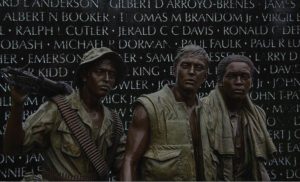 Etched into the wall of the Vietnam Veterans Memorial in Washington, D.C., are 58,307 names — service members killed or MIA during the war.
Etched into the wall of the Vietnam Veterans Memorial in Washington, D.C., are 58,307 names — service members killed or MIA during the war.
What’s missing is their faces. But a nationwide effort aims to change that lead by Janna Hoehn the Volunteer Team Leader for the Wall of Faces Vietnam Veterans Memorial Fund who has found the photos of more than 4,000 Texans so far as part of the overall national search.
The Wall of Faces project has existed only digitally since the effort began in 2009, on the foundation’s website. Plans are in the works for an education center adjacent to the actual wall in Washington, D.C. All of the photos will be submitted to the Wall of Faces online memorial as well as in the future Education Center that will be adjacent to the Vietnam Wall in Washington DC.
“Putting a face with a name changes the whole dynamic of the Wall, it keeps our fallen heroes memories alive and will honor them,” Hoehn said. “Our heroes stories and sacrifice will never be forgotten.”
Relatives and friends of men named on the wall should contact Ms. Hoehn. If unable to provide a photo, you are encouraged to pass along any other information, perhaps the name of a school that was attended. The project goal is to obtain a photo of every single Fallen Hero whose names are etched on The Wall. To date, over 50,000 photos have been collected. Also, Ms. Hoehn is seeking local volunteers to help search for obituaries or to look through high school yearbooks.
Please submit any photos or information to Janna Hoehn at neverforgotten2014@gmail.com.
(read more)
Celebrating Black History With The New York Times
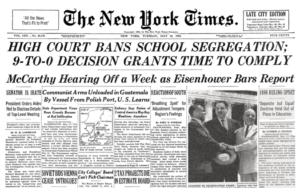 In recognition of Black History Month, here are Times articles from the past and present, as well as lesson plans, photographs, videos, infographics, crosswords, writing prompts and more for bringing the wealth of African-American history and culture into your classroom…an research.
In recognition of Black History Month, here are Times articles from the past and present, as well as lesson plans, photographs, videos, infographics, crosswords, writing prompts and more for bringing the wealth of African-American history and culture into your classroom…an research.
The package includes: Historic NYT Front Pages with the paper’s original black history-related news stories, select recent Times pieces on Black history and culture, arts, Politics, slideshows of Black History, and Learning Network Lesson Plans. (read more)
TIPHC Bookshelf
Published scholarship on black history in Texas is growing and we’d like to share with you some suggested readings, both current and past, from some of the preeminent history scholars in Texas and beyond. We invite you to take a look at our bookshelf page — including a featured selection — and check back as the list grows. A different selection will be featured each week. We welcome suggestions and reviews. This week, we offer, “Take-Off: American All-Girl Bands During World War II,” by Tonya Bolden.
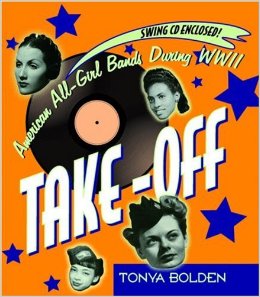 The 1940’s was a time when society thought it improper for women to make a sax wail or let loose hot licks on skins, but with the advent of World War II and many men away fighting the war, women finally got their chance to strut their stuff on the bandstand. These all-girl bands kept morale high on the home front and on USO tours of military bases across the globe while also helping to establish America’s legacy in jazz music.
The 1940’s was a time when society thought it improper for women to make a sax wail or let loose hot licks on skins, but with the advent of World War II and many men away fighting the war, women finally got their chance to strut their stuff on the bandstand. These all-girl bands kept morale high on the home front and on USO tours of military bases across the globe while also helping to establish America’s legacy in jazz music.
“Take-off?” Oh, yeah. Several all-girl bands did, including the “Prairie View Coeds” band featured in the book.
This book includes a hip swing CD.
From School Library Journal: “History and music are combined in this account of all-women bands during World War II. Information about jazz and swing underlies Bolden’s focus on the significance of female musicians who filled the void created by the war. They had to prove themselves in general and overcome ideas about what kind of music was appropriate for women to perform. Racism also impacted the ability of a number of the bands to tour the country. Bolden provides a wealth of material in this brief selection, and does so in a lively prose style and with frequent use of jazz vernacular. Photo captions and boxed inserts add interesting details. Endnotes; source lists of books, periodicals, and videos; a recommended reading list, and a discography are appended. This book would be most helpful for assignments on music or women’s history.”
This Week In Texas Black History, Jan. 29-Feb. 4
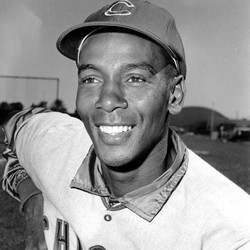 31 – On this date in 1931, Ernie Banks was born in Dallas. Banks attended Washington High School where he was a multi-sport star. He played with the Negro Leagues’ Kansas City Monarchs before becoming the first black player for the Major League Baseball Chicago Cubs. Known as “Mr. Cub,” Banks hit more home runs than anyone else in the majors from 1955 to 1960. He was elected to the Baseball Hall of Fame in 1977.
31 – On this date in 1931, Ernie Banks was born in Dallas. Banks attended Washington High School where he was a multi-sport star. He played with the Negro Leagues’ Kansas City Monarchs before becoming the first black player for the Major League Baseball Chicago Cubs. Known as “Mr. Cub,” Banks hit more home runs than anyone else in the majors from 1955 to 1960. He was elected to the Baseball Hall of Fame in 1977.
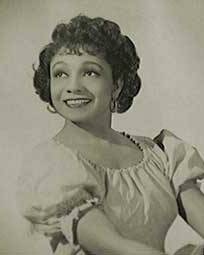 31 – On this date in 1934, Broadway and movie star Etta Moten (born in Weimar) sang for President and Mrs. Franklin D. Roosevelt at a White House dinner, marking the first time for an African-American woman to sing at the White House.
31 – On this date in 1934, Broadway and movie star Etta Moten (born in Weimar) sang for President and Mrs. Franklin D. Roosevelt at a White House dinner, marking the first time for an African-American woman to sing at the White House.
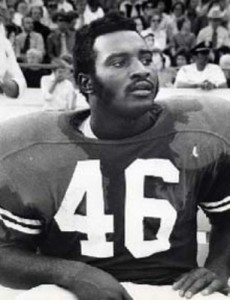 31 – Roosevelt Leaks, the first African-American Texas Longhorns player to earn All-America honors, was born on this day in Brenham, TX, in 1953. Leaks rushed for 2,923 yards and 26 touchdowns in his three seasons at Texas. “Rosey” was a consensus All-America selection in 1973 and finished third that year in Heisman Trophy voting. He played nine seasons in the National Football League with the Baltimore Colts (1975-79) and Buffalo Bills (1980-83).
31 – Roosevelt Leaks, the first African-American Texas Longhorns player to earn All-America honors, was born on this day in Brenham, TX, in 1953. Leaks rushed for 2,923 yards and 26 touchdowns in his three seasons at Texas. “Rosey” was a consensus All-America selection in 1973 and finished third that year in Heisman Trophy voting. He played nine seasons in the National Football League with the Baltimore Colts (1975-79) and Buffalo Bills (1980-83).
February
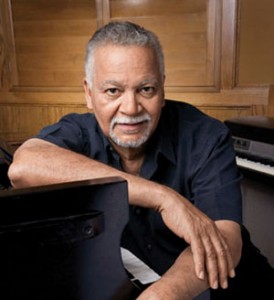 1 – Jazz pianist great Joe Sample was born on this day in Houston in 1939. Sample, a graduate of Phillis Wheatley High School in 1956, teamed with Wheatley classmates Wayne Henderson (trombone), Wilton Felder (saxophone), and drummer Nesbert “Stix” Hooper to form the Jazz Crusaders in the 1960s and the group became wildly successful and critically acclaimed. Sample began playing piano at age 5, and at age 16 entered Texas Southern University and studied there for three years before the Jazz Crusaders left Houston for Los Angeles to begin the group’s phenomenal career. Sample was a leader or sideman on multiple gold and platinum albums and was popular as a studio musician, including for Marvin Gaye’s “What’s Going On.”
1 – Jazz pianist great Joe Sample was born on this day in Houston in 1939. Sample, a graduate of Phillis Wheatley High School in 1956, teamed with Wheatley classmates Wayne Henderson (trombone), Wilton Felder (saxophone), and drummer Nesbert “Stix” Hooper to form the Jazz Crusaders in the 1960s and the group became wildly successful and critically acclaimed. Sample began playing piano at age 5, and at age 16 entered Texas Southern University and studied there for three years before the Jazz Crusaders left Houston for Los Angeles to begin the group’s phenomenal career. Sample was a leader or sideman on multiple gold and platinum albums and was popular as a studio musician, including for Marvin Gaye’s “What’s Going On.”
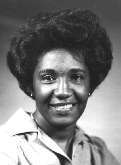 1 – On this date in 1936, Azie Taylor was born in St. John Colony in Dale, Texas, near Austin. Taylor married James Homer Morton on May 29, 1965, and in 1977, President Jimmy Carter named her the 36th Treasurer of the United States for which she is still the only African-American to have held the position. She was a graduate of Huston-Tillotson University.
1 – On this date in 1936, Azie Taylor was born in St. John Colony in Dale, Texas, near Austin. Taylor married James Homer Morton on May 29, 1965, and in 1977, President Jimmy Carter named her the 36th Treasurer of the United States for which she is still the only African-American to have held the position. She was a graduate of Huston-Tillotson University.
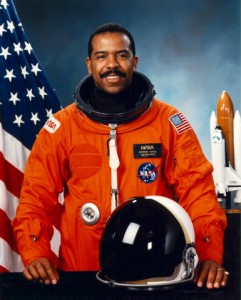 2 – In 1995, on this date, Dr. Bernard Harris, Jr. became the first African-American to walk in space. A native of Temple, Texas, Harris was payload commander aboard Space Shuttle Discovery Mission STS-63, the first flight of the joint Russian-American Space Program. The main objective of the mission was to test systems and techniques to be used on later missions to dock with the Russian Space Station Mir.
2 – In 1995, on this date, Dr. Bernard Harris, Jr. became the first African-American to walk in space. A native of Temple, Texas, Harris was payload commander aboard Space Shuttle Discovery Mission STS-63, the first flight of the joint Russian-American Space Program. The main objective of the mission was to test systems and techniques to be used on later missions to dock with the Russian Space Station Mir.
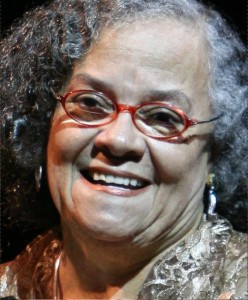 2 – On this date in 1927, musician Ernie Mae Miller was born in Austin. Miller was a graduate of L.C. Anderson High School, which was named for her grandfather. Miller played jazz, blues, gospel, and swing music and performed with the Prairie View Co-eds, a black, all-girl swing band from Texas that toured nationally during World War II. (See “Prairie View A&M University Coeds All Girl Band,” and “What if Jazz History Included the Prairie View Co-eds?” and the TIPHC Bookshelf for “Take-Off: American All-Girl Bands During World War II.”)
2 – On this date in 1927, musician Ernie Mae Miller was born in Austin. Miller was a graduate of L.C. Anderson High School, which was named for her grandfather. Miller played jazz, blues, gospel, and swing music and performed with the Prairie View Co-eds, a black, all-girl swing band from Texas that toured nationally during World War II. (See “Prairie View A&M University Coeds All Girl Band,” and “What if Jazz History Included the Prairie View Co-eds?” and the TIPHC Bookshelf for “Take-Off: American All-Girl Bands During World War II.”)
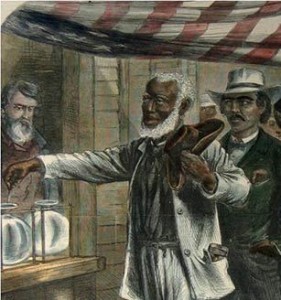 3 – On this day in 1870 the 15th amendment was ratified ensuring the right to vote to all male citizens of the United States, regardless of color or previous condition of servitude. The 15th Amendment opened the door for the elections of African-Americans to the U.S. Congress and to Southern local and state offices. Republicans wanted the 15th Amendment passed to obtain the vote of the freed slaves. However, many women suffragists had worked alongside Black suffragists like Frederick Douglass to gain the right to vote for both groups. However, when the 15th Amendment passed, it angered many women suffragists and some of them spoke out against Black suffrage. Women would not gain the right to vote until 1920.
3 – On this day in 1870 the 15th amendment was ratified ensuring the right to vote to all male citizens of the United States, regardless of color or previous condition of servitude. The 15th Amendment opened the door for the elections of African-Americans to the U.S. Congress and to Southern local and state offices. Republicans wanted the 15th Amendment passed to obtain the vote of the freed slaves. However, many women suffragists had worked alongside Black suffragists like Frederick Douglass to gain the right to vote for both groups. However, when the 15th Amendment passed, it angered many women suffragists and some of them spoke out against Black suffrage. Women would not gain the right to vote until 1920.
3 – On this day in 1956, Irma Jean Sephas became first African American undergraduate student at North Texas State University. Sephas, 41, was from Fort Worth and majored in business with a music minor. She had previously attended Huston-Tillotson College in Austin.
Blog: Ron Goodwin, author, PVAMU history professor
 Ron Goodwin’s bi-weekly blog appears exclusively for TIPHC. Goodwin is a San Antonio native and Air Force veteran. Generally, his column addresses contemporary issues in the black community and how they relate to black history. He and the TIPHC staff welcome your comments.
Ron Goodwin’s bi-weekly blog appears exclusively for TIPHC. Goodwin is a San Antonio native and Air Force veteran. Generally, his column addresses contemporary issues in the black community and how they relate to black history. He and the TIPHC staff welcome your comments.
Read his latest entry, “To Tell the Truth,” here.
Submissions Wanted
Historians, scholars, students, lend us your…writings. Help us produce the most comprehensive documentation ever undertaken for the African American experience in Texas. We encourage you to contribute items about people, places, events, issues, politics/legislation, sports, entertainment, religion, etc., as general entries or essays. Our documentation is wide-ranging and diverse, and you may research and write about the subject of your interest or, to start, please consult our list of suggested biographical entries and see submission guidelines. However, all topics must be approved by TIPHC editors before beginning your research/writing.
We welcome your questions or comments via email or telephone – mdhurd@pvamu.edu.
